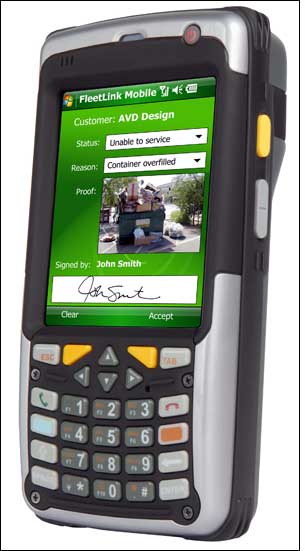Monroe County, Miss., is employing an RFID-based system to track its garbage trucks, document the waste carts containing refuse that have been picked up and ensure the county bills residents appropriately for the service being provided.
The system enables the county to track 8,600 waste carts and five trucks as they pick up residential waste and bill residents for the pickups. Since fully deploying the system in August 2009, the county has identified 600 locations in which residents were receiving pickup service without being billed, according to Martin Demers, CEO of FleetMind Solutions, which provided the system’s hardware, software and integration.

Those unbilled pickups were the main challenge the county faced before implementing the system—the county wanted to identify which homes were using the municipality’s waste-management service without paying for it. County and state laws require the county to pick up all garbage that residents place on the side of the street, and to bill them accordingly for that service. In some cases, identifying which residence the waste came from wasn’t easy. Waste-management employees emptied carts left out on the street without knowing specifically if a customer was paying for the service, or if the cart belonged to the home where it was placed.
To resolve the problem, the county went to its garbage-equipment provider Labrie Environmental Group, which recommended FleetMind. The county then chose to distribute its own carts to all residents using the FleetMind solution, and to have them fitted with RFID tags for easy and immediate identification. The county researched cart delivery and management solutions for approximately two years, then chose FleetMind’s system, which the company began installing in April.
The FleetMind system has been in use by private waste-hauling companies and some public waste-management agencies for the past five years, Demers says. It includes handheld RFID-enabled computers for initial cart delivery, fixed readers on truck hoppers, a GPS system to pinpoint each truck’s location at all times, and an onboard computer with a flat screen displaying details regarding the vehicle’s location and each pickup as it occurs. The system also includes software to manage data from RFID reads on the truck’s computer, as well as in the firm’s back-end database.
According to Demers, the EPC Gen 2 passive UHF RFID tags can either be attached to existing waste carts, or embedded inside the carts by the cart manufacturer. In the case of Monroe County, the tags were embedded in the front of each new 90-gallon plastic cart.
Monroe County’s drivers delivered the new tagged receptacles to each resident, and utilized an RFID-enabled handheld computer (designed and assembled by FleetMind) to capture a cart’s unique ID number. The drivers then used the handheld’s keypad to input that customer’s address, which was linked to other data in the county’s back-end system, such as the home’s GPS coordinates, scheduled pickup dates and times, and information as to which truck will make the pickups.
When a truck later begins its pickups, the FleetMind software on the onboard computer alerts the driver to each forthcoming stop, including the next address on the pickup route and which cart ID numbers should be on the curb. When the truck picks up the cart with its mechanical arm, the cart is lifted toward the vehicle’s hopper, where the fixed interrogator (made by FleetMind with Alien Technology components) captures the cart’s unique ID number. That ID number, along with the address and GPS coordinates, is sent to the back-end server via a GPRS transmission.
The software allows both the county and the driver to then receive an alert if a pickup has been missed, if a cart has been emptied that lacked an RFID tag, or if a specific cart is emptied at the incorrect address (for instance, if it were emptied in front of a house to which it had not been assigned). On a map of the truck’s route, maintained on the back-end software, the county’s employees can view the truck’s exact location in real time, along with color-coded icons indicating which carts have been emptied—and at which addresses—as well as which have not.
There have been several key benefits to using the system, according to a county spokesperson: more accurate invoicing and billing information, additional revenues from carts that were being emptied and not billed, improved route efficiencies and better customer service, because the county now knows where each truck is located, in real time, as well as which carts have been emptied.
The county is a member of a seven-county co-operative that eventually intends to implement this service, Demers says. “We’ve been doing this for many years, and our system has become very sophisticated. It provides a lot of information,” he states, adding, “In most cases, users see a return on investment in six months or less.”

